
Welcome to the biweekly electronic newsletter from Stanford Bio-X for members of the Bio-X Corporate Forum. Please contact Dr. Hanwei Li, the Bio-X Corporate Forum Liaison if you would like to be added or removed from this distribution list, or if you have any questions about Stanford Bio-X or Stanford University.
Highlights
** On October 9, 2013, Bio-X celebrated the 10th Anniversary of the James H. Clark Center, the hub of Bio-X. Check out CLARK CENTER @ 10X as well as the Bio-X Timeline over the last 15 years!!
** Check out the article by Stanford President John Hennessy in the Nov/Dec 2013 issue of the Stanford Magazine on Bio-X and the Clark Center, "A Cauldron of Innovation".
Seed Grants
**UPDATE: BIO-X HAS 22 NEWLY AWARDED IIP SEED GRANT PROJECTS FOR ROUND 7 in 2014!! Click on the link to check out the project descriptions and read on to learn more about this round!
 SEED GRANTS FOR SUCCESS - Stanford Bio-X Interdisciplinary Initiatives Program (IIP)
SEED GRANTS FOR SUCCESS - Stanford Bio-X Interdisciplinary Initiatives Program (IIP)
The Bio-X Interdisciplinary Initiatives Program represents a key Stanford Initiative to address challenges in human health. The IIP awards approximately $3 million every other year in the form of two-year grants averaging about $150,000 each. From its inception in 2000 through the fifth round in 2010, the program has provided critical early-stage funding to 114 different interdisciplinary projects, involving collaborations from over 300 faculty members, and creating over 450 teams from five different Stanford schools. From just the first 5 rounds, the IIP awards have resulted in a 10-fold-plus return on investment, as well as hundreds of publications, dozens of patents filed, and most importantly, the acceleration of scientific discovery and innovation.
This year is the 7th round of the Bio-X IIP Seed Grants Program, and Bio-X has just announced it's 22 newly awarded projects selected from 142 Letters of Intent (LOIs)! This has been the largest number of LOIs that Bio-X has received. Please go here to check out the newly awarded projects. Competition was intense, and the selection criteria included innovation, high-reward, and new interdisciplinary collaborations. (To view the 142 other IIP projects that have been funded from the previous 6 rounds, please click here.)
We are cultivating and are highly successful in building meaningful collaborations with numerous corporate colleagues. New collaborations through our seed grant projects are highly encouraged. To learn about how to get involved, please contact Dr. Hanwei Li or Dr. Heideh Fattaey.
**On August 27, 2014, over 300 people attended Bio-X's latest Interdisciplinary Initiatives Seed Grants Program Symposium. There were 8 different oral presentations from faculty members who were awarded Bio-X Seed Grants on the progress that they have made with the funding towards their projects. In addition, Bio-X had its largest poster session ever with 167 posters presented during the reception of the symposium! If you'd like to learn more about any of the projects that were presented during the entire symposium, please contact Dr. Hanwei Li with your questions.
Fellowships
Every year, graduate students and postdoctoral scholars of Bio-X affiliated faculty are highly encouraged to apply for the Bio-X Fellowships, which are awarded to research projects that are interdisciplinary and utilize the technologies of different fields to solve different biological questions. Students are encouraged to work collaboratively with professors of different departments, thus creating cross-disciplinary relationships among the different Stanford schools. Our fellows have conducted exciting research, resulting in publications in high-impact journals and have been offered excellent positions in industry and academia.
To date, with the 19 new awardees of 2014, Stanford Bio-X has a total of 173 Fellows.
You can view the numerous Fellowship projects that have been awarded over the years as well as oral presentations from previous symposiums here.
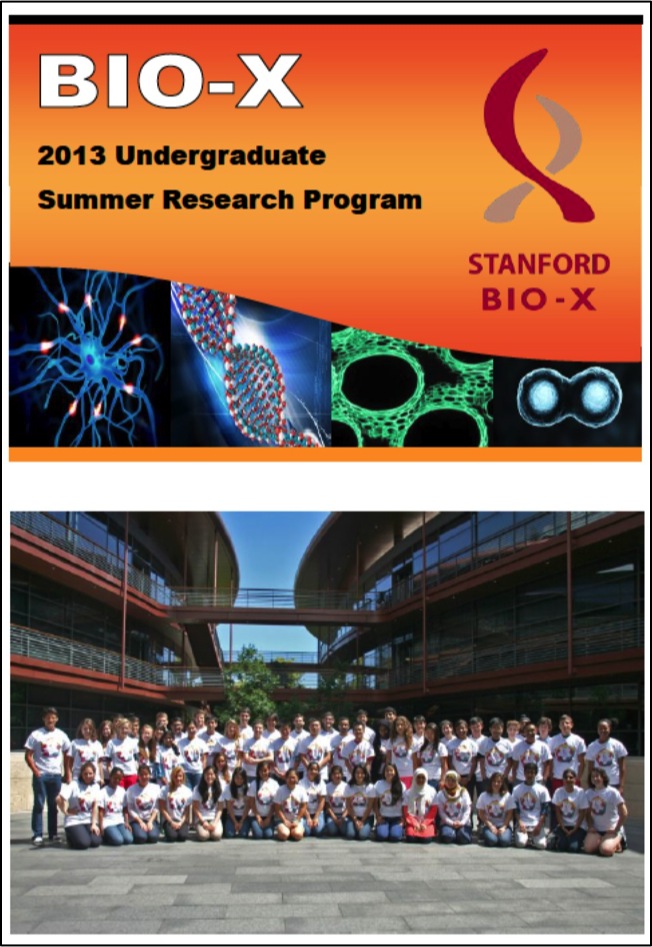 BIO-X UNDERGRADUATE SUMMER RESEARCH PROGRAM
BIO-X UNDERGRADUATE SUMMER RESEARCH PROGRAM
The Bio-X Undergraduate Summer Research Program supports undergraduate research training through an award designed to support interdisciplinary undergraduate summer research projects. The program is an invaluable opportunity for students to conduct hands-on research, learn how to carry out experiments in the laboratory, and develop the skills to read and analyze scientific literature. This program is eligible to Stanford students who want to work in the labs of Bio-X affiliated faculty.
To date, with 65 new awardees from 154 applications submitted this year, 306 students have been awarded the opportunity to participate in the Bio-X Undergraduate Summer Research Program.
Participating undergraduates are also required to present poster presentations on the research that they've conducted during the program. Please click here for title lists of past posters that our undergraduates have presented.
Many fruitful collaborations and relationships have been established with industry through fellowships. Please contact Dr. Hanwei Li or Dr. Heideh Fattaey if you'd like to learn more about how to get involved with these fellowship programs.
News
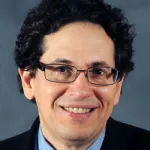 Retinal-scan analysis can predict advance of macular degeneration, study finds
Retinal-scan analysis can predict advance of macular degeneration, study finds
Bio-X Affiliated Faculty Daniel Rubin
Bio-X IIP Seed Grant Project: Computerized Quantitative Imaging Assessment of Age-Related Acute Macular Degeneration
Stanford University School of Medicine scientists have found a new way to forecast which patients with age-related macular degeneration are likely to suffer from the most debilitating form of the disease. The new method predicts, on a personalized basis, which patients’ AMD would, if untreated, probably make them blind, and roughly when this would occur. Simply by crunching imaging data that is already commonly collected in eye doctors’ offices, ophthalmologists could make smarter decisions about when to schedule an individual patient’s next office visit in order to optimize the chances of detecting AMD progression before it causes blindness. AMD is the leading cause of blindness and central vision loss among adults older than 65. An estimated 10-15 million people in the United States suffer from the disease, in which the macula — the key area of the retina responsible for vision — shows signs of degeneration. During normal aging, yellowish deposits called drusen form in the retina, which is the light-sensitive layer of tissue at the back of the eye. As drusen increase in size and number, they eventually begin to damage the light-sensitive cells of the macula. This stage of the disease, called “dry” AMD, can mean blurry central vision and impaired day-to-day activity. While about four of every five people with AMD have the dry form of the disease, it’s the so-called “wet” form that most concerns ophthalmologists, because it accounts for 80-90 percent of all legal blindness associated with the disease. In wet AMD, abnormal blood vessels accumulate underneath the macula and leak blood and fluid. When that happens, irreversible damage to the macula can quickly ensue if not treated quickly. But until now, there has been no effective way to tell which individuals with AMD are likely to progress to the wet stage. Current treatments are costly and invasive — they typically involve injections of medicines directly into the eyeball — making the notion of treating people with early or intermediate stages of AMD a non-starter. Doctors and patients have to hope the next office visit will be early enough to catch wet AMD at its onset, before it takes too great a toll.
 Oxytocin levels in blood, cerebrospinal fluid are linked, study finds
Oxytocin levels in blood, cerebrospinal fluid are linked, study finds
Bio-X Affiliated Faculty Karen Parker
Bio-X IIP Seed Grant/NeuroVentures Project: Biomarkers of the social deficits of children with autism
For years, scientists have debated how best to assess brain levels of oxytocin, a hormone implicated in social behaviors. Now, researchers at the Stanford University School of Medicine have found the first direct evidence in children that blood oxytocin measurements are tightly linked to levels of oxytocin in cerebrospinal fluid, which bathes the brain. Low oxytocin levels in blood and CSF are both correlated to high anxiety levels, the research also showed. The findings were published online Nov. 4 in Molecular Psychiatry. “So many psychiatric disorders involve disruptions to social functioning,” said the study’s senior author, Karen Parker, PhD, assistant professor of psychiatry and behavioral sciences. “This study helps scientifically validate the use of measuring oxytocin in the blood, and suggests that oxytocin may be a biomarker of anxiety. It raises the possibility that oxytocin could be considered as a therapeutic target across a variety of psychiatric disorders.”
 Stanford engineers discover how to record the forensic history of chemical contaminations in water
Stanford engineers discover how to record the forensic history of chemical contaminations in water
Bio-X Affiliated Faculty Sindy Tang
Stanford engineers have invented a device that can record when chemicals appear in water and in what concentration, without electronics, creating a simple and inexpensive sensor to find unknown sources of contaminations in streams. Sindy K.Y. Tang, an assistant professor of mechanical engineering, described what she calls her time capsule technology in a paper in the journal Lab on a Chip. The time capsule captures a visible record of chemical reactions, like a barcode, that can be scanned to reveal when the reaction occurred and how much of a specific chemical was present. "We record the forensic history of chemical reactions," Tang said. Because the time capsule has no mechanical or electrical parts, it uses no electricity and requires no batteries. That feature allows Tang to make devices that are smaller and cheaper than current sensors. Now she plans to make her prototype smaller and extend the range of reactions it can record to open up new uses such as studying geothermal or petroleum reservoirs deep underground – places where pressure and temperature could destroy conventional electronic sensors.
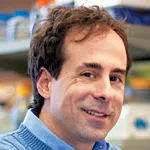 New way of genome editing could cure hemophilia in mice; may be safer than older method, study shows
New way of genome editing could cure hemophilia in mice; may be safer than older method, study shows
Bio-X Affiliated Faculty Mark Kay
The ability to pop a working copy of a faulty gene into a patient’s genome is a tantalizing goal for many clinicians treating genetic diseases. Now, researchers at the Stanford University School of Medicine have devised a new way to carry out this genetic sleight of hand. The approach differs from that of other hailed techniques because it doesn’t require the co-delivery of an enzyme called an endonuclease to clip the recipient’s DNA at specific locations. It also doesn’t rely on the co-insertion of genetic “on” switches called promoters to activate the new gene’s expression. These differences may make the new approach both safer and longer-lasting. Using the technique, the Stanford researchers were able to cure mice with hemophilia by inserting a gene for a clotting factor missing in the animals. “It appears that we may be able to achieve lifelong expression of the inserted gene, which is particularly important when treating genetic diseases like hemophilia and severe combined immunodeficiency,” said Mark Kay, MD, PhD, professor of pediatrics and of genetics. “We’re able to do this without using promoters or nucleases, which significantly reduces the chances of cancers that can result if the new gene inserts itself at random places in the genome.” Using the technique, Kay and his colleagues were able to insert a working copy of a missing blood-clotting factor into the DNA of mice with hemophilia. Although the insertion was accomplished in only about 1 percent of liver cells, those cells made enough of the missing clotting factor to ameliorate the disorder. Kay is the senior author of the research, published Oct. 29 in Nature. The lead author is postdoctoral scholar Adi Barzel, PhD.
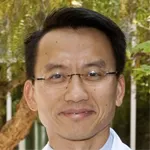
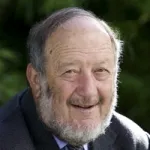 New molecular imaging technology could improve bladder-cancer detection, researchers say
New molecular imaging technology could improve bladder-cancer detection, researchers say
Bio-X Affiliated Faculty Joseph Liao and Irv Weissman
Researchers at the Stanford University School of Medicine have developed a new strategy that they say could detect bladder cancer with more accuracy and sensitivity than standard endoscopy methods. Endoscopy refers to a procedure in which surgeons use an instrument equipped with a lens to see inside the patient. The researchers identified a protein known as CD47 as a molecular imaging target to distinguish bladder cancer from benign tissues. In the future, this technique could improve bladder cancer detection, guide more precise cancer surgery and reduce unnecessary biopsies, therefore increasing cancer patients’ quality of life. The work is described in a paper published Oct. 29 in Science Translational Medicine. Bladder cancer, the fifth most common cancer in the United States, is generally identified in the clinic by a procedure called cystoscopy, an endoscopy in the bladder. Then in the operating room, surgeons remove the cancerous tissue for biopsy.
Events
| Molecular Imaging Program at Stanford (MIPS) Nov 13, 2014, 5:30 pm - 6:30 pm Beckman Munzer Auditorium, Stanford, CA CCNE Nano-Bio Seminar Series: "Highly Fluorescent Semiconducting Polymer Dots for Biology and Medicine" Speaker: Daniel T. Chiu, PhD, Univ. of Washington |
Bioengineering Nov 13, 2014, 11 am - 12 pm Clark Center S360, Stanford, CA Frontiers in Quantitative Biology Series Speaker: Suzanne Gaudet, Harvard Med School |
| Stanford Bio-X Nov 17, 2014, 12 pm - 1:05 pm Clark Center S361, Stanford, CA Bio-X Frontiers in Interdisciplinary Biosciences Pre-Seminar (in anticipation of Dr. Lior Pachter's seminar on Nov 20) Speaker: Julia Salzman, PhD, Stanford |
Stanford Bio-X Nov 20, 2014, 12 pm - 1:05 pm Clark Center S360, Stanford, CA Bio-X Frontiers in Interdisciplinary Biosciences Seminar, "Recent Developments in RNA-Seq" Speaker: Lior Pachter, PhD, UCB |
Resources
| Stanford University |
| Stanford Bio-X |
| Bio-X Seed Grants The Stanford Bio-X Interdisciplinary Initiatives Program (IIP) provides seed funding for high-risk, high-reward, collaborative projects across the university, and have been highly successful in fostering transformative research. |
| Office of Technology and Licensing "Techfinder" Search the OTL Technology Portal to find technologies available for licensing from Stanford. |
| Stanford Center for Professional Development - Take advantage of your FREE membership! - Take online graduate courses in engineering, leadership and management, bioscience, and more. - Register for free webinars and seminars, and gets discounts on courses. |
| Stanford Biodesign Video Tutorials on how FDA approves medical devices A series of video briefs recently produced by the Stanford Biodesign Program teaches innovators how to get a medical device approved for use in the United States. This free, online library of 60 videos provides detailed information on the Food and Drug Administration regulatory process, short case studies and advice on interacting with the FDA. |
To learn more about Stanford Bio-X or Stanford University, please contact Dr. Hanwei Li, the Bio-X Corporate Forum Liaison, at 650-725-1523 or lhanwei1@stanford.edu, or Dr. Heideh Fattaey, the Executive Director of Bio-X Operations and Programs, at 650-799-1608 or hfattaey@stanford.edu.


